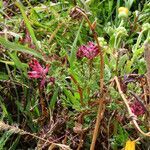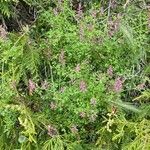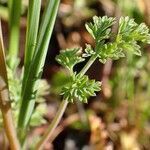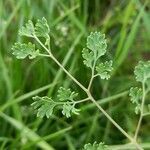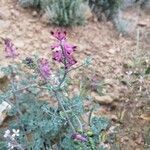Tufted or scrambling annual herb. Lvs crowded to distant; lamina dissected, pale, glaucous, up to 8 × 4 cm; segments linear or linear-lanceolate, occasionally narrowly cuneiform. Infl. dense, becoming lax at fruiting, with (10)-20-40 fls; rachis > peduncle, especially at fruiting. Peduncles stout, 1-3 cm long; bracts oblong, pale, membranous, pink at tips, < pedicels, 1-2 × 0.5-0.8 mm. Sepals ovate to narrow-ovate, dentate, acute, 2-2.5 × 0.7-1 mm. Corolla purplish pink with dark green and purple tips, (6)-7-8-(9) mm long; lower petal spoon-shaped with widely-spreading margins at tip. Fr. broadly obovoid, broader than long, c. 2 × 2.5 mm, rugose when dry; apex truncate to retuse; apical pits small.
Herbs, 15-50 cm tall, diffusely branched and leafy throughout. Leaf lobes linear to narrowly oblong, to 1.5 mm wide. Raceme 10-40-flowered, usually shortly stalked; bracts oblong, ca. 1/2 to as long as spreading to erect-spreading rigid fruiting pedicels 4-6 mm. Sepals 2-3.5 × 1-1.5 mm, dentate. Corolla pink or pale amaranth; upper petal 7-9 mm, spur 2-2.5 mm, marginal wings often darker; lower petal narrowly subspatulate with long claw, limb ± dentate; inner petals tipped with dark purple. Infructescence 4-9 cm; fruiting pedicels 5-6 mm, straight and slightly thickened. Nut subreniform-truncate in profile, broader than long, ca. 2 × 2.5 mm, faintly rugulose. Fl. and fr. May-Sep. 2n = 32.
Lax but rather robust, diffusely branched, 2–8 dm; racemes dense, many-fld, 2–4 cm; cor 8 mm, the tube red-purple, the summit dark red; fr 2.5 mm. Native of Europe, intr. in waste ground here and there in our range; 2n=32. May–Aug.
A robust herb with weak stems. It is an annual plant and is sprawling or climbing. The leaves are grey-green and finely divided. They are 5-15 cm long. The flowers are pink and 7 mm long. They are in dense elongated groups.
